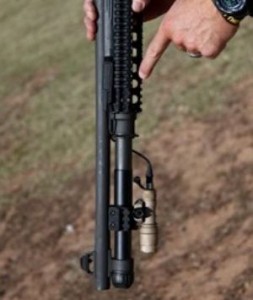
This Benelli M-4 sports weapon-mounted light (SureFire Scout with pressure switch) and rugged front sight. Both are critical components on a defensive shotgun.
Home Defense Shotgun Set-Up
While your hunting shotgun might serve the purpose of a self-defense tool, in some cases it might not be your best choice. Hunting shotguns often are long-barreled guns found in single shot, double barrel, or pump action. While a pump-action gun is fine, I do not recommend using a single or double shotgun for self-defense due to ammunition capacity limitations. It’s possible that you may have to shoot more than once or twice during a fight, and reloading (or even retaining ammunition in) a gun like this under stress is difficult. Also, maneuvering around doorways or obstacles gets tougher as the barrel of a long gun gets longer. A long hunting shotgun is going to be very hard to move around things, and will also force you farther from a position of cover when engaging. Consider getting a good handgun if the above dictates that your shotgun may not be up to par.
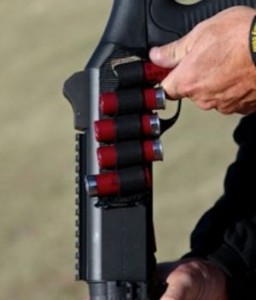
Since a shotgun is limited by the amount of ammunition it can be loaded with (usually no more than seven to nine rounds), It’s critical to have spare ammunition located on the gun. A side saddle like this also allows users to carry a different type of ammunition, such as slugs, if they are a viable option.
- – 20 gauge or larger (12 gauge is preferable)
- – Ammunition capacity of at least five shells
- – Additional ammunition carrier that holds three to five shells on the gun
- – Sights visible enough to see in low light
- – Weapon-mounted light
- Optional but desirable features are:
- – Barrel length no more than 20 inches
- – Sling
- – Electronic sight (such as an Aimpoint Micro dot sight)
Shooting a Shotgun Effectively
The following are some basic tips on shooting your shotgun effectively. They need to be trained and modified in the context of a self-defense shooting situation. When using a shotgun, in the best case your total ammunition capacity is probably around nine rounds in the gun and possibly another five on it (in a sidesaddle). This means that if you deploy the shotgun without grabbing some additional ammunition, you will be much more limited compared to, for example, an M-4/16 type rifle, where if you grab a gun with a magazine cinch system (two magazines cinched together), you will have closer to 60 rounds of ammunition. For home defense, 14 rounds will suffice in 99% of the situations you may need the shotgun for, but if you are in the military or law enforcement, I recommend that you purchase and use quick clips or a good bandoleer for reloading.
Shooting effectively requires that you build a mechanical platform that will allow you to control the shotgun effectively. Compared to an M-4 or any other .223-caliber rifle, a shotgun will offer significantly more recoil. Learning how to control the recoil will aid in getting combat-effective hits, as well as follow-up hits faster.
Square the body and weight forward.
Most shooters will want to blade the body off more than necessary. Squaring up with the strong foot only slightly back will allow you to mount the rifle in a more centered position on the chest (see below). Staying centered offers the benefit of allowing the pelvic girdle to stay as square as possible to the target, improving the stability and mobility of the shooter. Weight forward simply means that the nose should be over the toes. To test this, go ahead and stand square to a friend, drop the strong-side foot back slightly, unlock the knees, and stand upright. Have your friend push back on the center of your chest. Next, leaning forward (without bending the knees much more) and placing your nose barely in front of your toes, have your buddy push on you again. You (and he) will find that simply shifting the upper body weight forward of your center of balance offers substantial recoil potential due to the weight shift.
Grip the shotgun high with the strong hand.
We often use this term with a handgun, but it applies to a shotgun too. Your grip with the shooting hand (the one on the pistol grip or stock that controls the fire systems) should be as high on the pistol grip (or forward if using a standard stock) as possible. Once you find this position, make sure you apply grip pressure and pull the shotgun straight to the rear into the chest (where the stock is mounted) when shooting. Simply resting the hand there will not do the trick.

Principles of a solid shooting stance in action: aggressive forward lean, pelvic girdle square, stock centered, strong cheek weld, elbow tucked!
The biggest mistake I have seen is actually moving the support hand back and grasping the magazine well. Gripping forward on the handguard will do several things. First, it will increase the recoil control of that hand (due to an increase of leverage on the front of the gun). Second, it offers a better mechanical advantage if one has to snap the gun to a new target (once again due to leverage). Last, when gripping the gun forward with the support hand, the shooter will have much more leverage if he is forced to try to retain his gun from a surprise close-range attack. When gripping the gun with the support hand, ensure that you are gripping the handguard and pulling the shotgun straight to the rear.
Mount the shotgun as centered as possible.
This is a major key to controlling recoil, and one that almost everyone I have worked with misses to some extent. Like many of you, I was taught a standard bladed stance (by both my father and the U.S. Marine Corps) that is more traditional and places the stock on the outer portion of the shoulder. The problem is that this placement of the stock allows the gun to turn the body as the shotgun pushes backward. This causes the sights (or dot) to cycle high right or left (for a left-handed shooter).
To find this centered spot on your chest area, stand relatively square to the target with the head erect and looking forward. Now grab the stock of the shotgun and place it on the center of your chest. Drive your chin down onto the stock until you find a good cheek weld spot that allows you to see the sights or through the scope. As you drive your chin down, the shotgun will have to move slightly to either the right or left side (right-handed shooters, right side; lefties, the opposite) but will stay relatively centered on the chest. You might find that this places pressure on your cheek in relation to the shotgun, which is good. Any time I am shooting a shotgun, I focus on “pressuring” my cheek into the stock to increase my control on the gun and minimize dot movement.
Key Tip: Another great side benefit of centering the gun (while squaring up) is that, while shooting on the move, the gun will move much less, since it is centered on the chest rather than on the outside of the shoulder. The shoulders move while walking, which translates movement to the gun; therefore centering on the chest minimizes movement a lot!
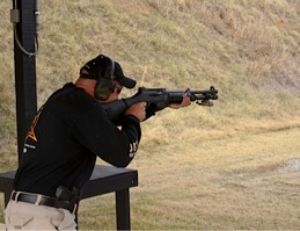
Firing third shot in a rapid-fire sequence, author is still very much in control of recoil due to aggressive shooting stance.
Once you have mounted the shotgun in the manner described above, your next area of focus will be to drop the strong-side elbow. This will do a couple things for you. First, it will flex the front deltoid and pectoral muscle on that side of the chest. (Go ahead and test that: place your hand on your deltoid/pectoral area with the elbow out to the side and then drop it straight down.) Second, it will keep the elbow low and out of the way so that it is less likely to get hit by bullets when shooting around cover, or bump into obstacles or people when you are moving.
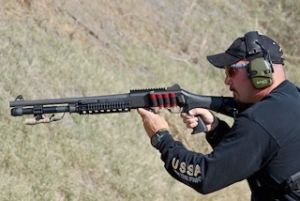
Author has completed his scan process and is reloading shotgun with same number of rounds fired during the drill. Keeping a shotgun fed is a key consideration in a defensive shooting. You do not want to run out of ammunition, especially if you don’t carry a handgun to transition to!
Now that you have mounted the shotgun into a secure “platform,” all you have to do is minimize the movement and press. The pressure on the gun should be substantial but also neutral in a sense (straight to the rear except for the pressure required to hold the shotgun upright), therefore be careful to ensure that you don’t pull the shotgun off to one side or another.
If you fire several rounds with a shotgun, it’s critical to remember that it needs to be reloaded; therefore I teach and recommend one of two sequences when shooting your shotgun:
Pump Shotgun: Shoot it, pump it, scan, and load it.
Auto Shotgun: Shoot it, scan, and load it.
If I shoot three shots, as soon as I deem my area secure (during my scan process), I load the shotgun with three more rounds. We should always be preparing for the next fight!
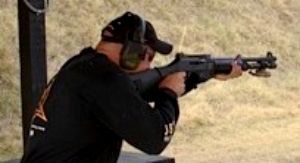

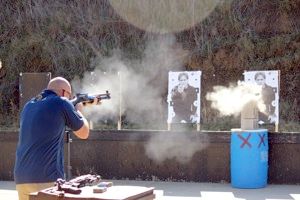
Great advice and instructions. I was train back in the late 80's with an Ithaca MP 12 gauge which is kind of outdated these days. I decided to trade it in for a Mossberg 500 ATI Destroyer which is also a 12 gauge. Your article gave me some new insights and refreshed my old memories of my training. I was wondering what do you think of the Mossberg 500 ATI? Is hard to find a Shotgun range in NYC to get retrain our to sharpen my skills with this new toy of mine. Anyway thanks for the tips and Stay safe!
Great points all around. A 12 ga. shotgun loaded with #4 buck shot gets the job done without over penetration like an AR. The larger pattern and extra projectiles should mitigate having fewer rounds than an AR magazine. A shotgun brings an intimidating force into an encounter with an intruder.
I've noticed the good info. BUT I don't see why a .410 with good loads should be avoided if said scattergun is already in hand. There has been a growing number of personal defense loads on the market (granted the majority are meant to be used in revolvers BUT they do come into their own when fired from a shotgun) While there aren't as many #4 Buck pellets loaded into a 3-inch .410 shell it's still better than using bird shot. Also one needs to take into account what a 2-1/2 inch 1/4 ounce slug can do (though said load shouldn't be used if in close proximity to other dwellings) once it impacts a body,from what I've seen foster slugs break apart after a bit of travel through tissue and that goes for any of the three common Calibers/Gauges. I understand that a .410 isn't in the same class as a 12 or 20 but it's still not something to sneeze at, even more so when compared to standard pistol caliber performance. I own all three gauges so I'm not lacking in choices. Yet the .410 seems to be the most logical from the standpoint of being able to be used by many different members of the household. It also makes for a good pest removal tool (While following all local laws regarding such) I would like to see you take an honest look at Mossberg's 500 E series Model #50454 with the following loads #1: Federal Premium personal Defense 3-inch #4 Buckshot (9-pellet) #2:Federal 2-1/2 inch '000' Buckshot (4-pellet), and either remington or winchester 2-1/2 inch foster slugs What do you say Mr. Seeklander?
Very nice article and straight to the point. I am not sure if this is really the best place to ask but do you guys have any ideea where to get some professional writers? Thanks :)
Is the shotgun training the same as one would find in a Police Shotgun course, such as learning how to combat load?
What about the MKA 1919 or Saiga for home defense applications?
It is very interesting topic Zeeshan Mughal
I am no expert, but I have military and law enforcement training and experience and I have completed the Front Sight Nevada defensive shotgun course three times. Your article seems spot on to me and contains very good basic advice on shooting shotguns for defense. Thank you.
I just bought a new mossburg12ga. with 20" barrell. I haven't shot it yet, actually haven't shot a long gun at all in many years. I have 3 pistols, and the long guns are definetly different for me. I Enjoyed reading the articles , they were very informative. I am looking forward to shooting my new gun in the future and practicing. What is the shell you suggest,? I know 00 buck, but to minimize wall pentatration but still do maximum damage?
Great article.